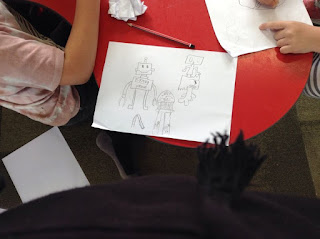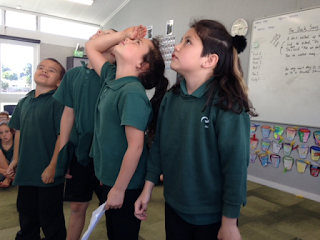Our Seesaw Blog Please click on link
Posts
Tangrams and Stop Motion
- Get link
- X
- Other Apps

Tangrams and how to use Stop Motion Our provocation was based around a Chinese myth that we viewed on YouTube. Then we discussed the language needed to follow a tangram pattern for example slide, rotate, quarter turn. We practiced making tangram shapes and patterns that had clear edges. Next we challenged ourselves by trying to duplicate tangram shadows with no edges. Very hard to do but we could do it! Finally we had to use Stop Motion to get our tangrams to move. Some challenges we experienced were keeping the camera still, making the movements too short or too long and not having enough shots.
Creative Learning
- Get link
- X
- Other Apps

Creative Learning What? – Children have been learning to creatively elaborate on their ideas. Why? – Studies show that creative elaboration is declining significantly in children and adults. Creative elaboration is when you take an idea and expand on it in an interesting and novel way. This is especially worrying because creative elaboration is a better predictor of real world achievement than test scores. How? – We started by providing children with a variety of topic choices. This gave children choice and some control over the topics making this a more playful experience. For example, design a playground that would be fun for Bromley school children, design a robot to complete your homework, design a bug catcher, make a catapult that will work out of ice cream sticks etc We also share three unrelated pictures and simply state, “What if....” - Children had to state the what it is, how it works and why it was or is a good d...
Clubs 2019
- Get link
- X
- Other Apps

Club Day runs every Thursday for one hour during the morning. Children get to suggest different clubs they would like and then opt into a club that interests them. Children on a regular basis have to reflect on the process. Research says that clubs are pro-social and help to develop social cohesion. Activities have been known to have positive effects on behaviour, manifested by reduced behaviour problems, increased levels of responsibility, increased self-esteem, enhanced status among peer groups, and pride in accomplishments/participation. Through clubs children can follow their passions and run with them. Children need to try things, see what works, see what they like, see what they get out of them. Participating in club activities helps improve communication skills which is a vital skill to have both at primary, intermediate, high school and the work place. Often the club members creatively work in teams and team work ...
Inquiry
- Get link
- X
- Other Apps
What makes me unique? Who am I? Our guided inquiry with the purpose of establishing a process that children will eventually have greater ownership and autonomy of. Literacy - Speaking, writing and presenting Show some understanding of how to shape texts for different purposes and audience Select form and express ideas on a range of topics Social Sciences Understand how people make significant contributions to New Zealand’s society Understand how people make choices to meet their needs and want OUR PROVOCATION First we viewed a video https://www.youtube.com/watch?v=RUup841pZrs What do you want to be and how is this going to give back to family and community? Why do you think we need to give back to the community? Why is it necessary? - A brainstorm of ideas What do I want to be in the future? How am I going to give back to my community? Where do you want to be in the future? What are the things I need to be doing/learning/focusing on to be where I want to be in th...
The world's most dangerous walks to school
- Get link
- X
- Other Apps

The world's most dangerous walks to school First we discussed how lucky we are to live in NZ and how we should be very grateful for this. Then for each photo the teacher read an article the accomponied the photo. There were many comments made by the children including.. "This is sad" "I never new that people that had school had to make such dangerous trips" "I can't imagine what it is like" Children then had to put themselves in someone else's shoes. They had to do this by describing what the journey was like. They did this by describing... - What did you see? -What did you smell and taste? -What were you thinking and feeling?
